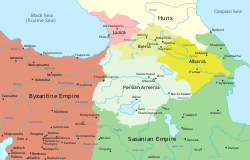
Back إيبيريا الساسانية Arabic Σασσανιδική Ιβηρία Greek ویروزان Persian Ibérie sassanide French Վրաց մարզպանություն Armenian სასანური ქართლი Georgian Марзпанство Иберия Russian
Sasanian Iberia | |||||||||||
|---|---|---|---|---|---|---|---|---|---|---|---|
| 255/6–299a 363–580b 580–627c | |||||||||||
 Map of the Caucasus in 387–591 | |||||||||||
| Status | Province of the Sasanian Empire | ||||||||||
| Capital | Armazi Mtskheta Tbilisi | ||||||||||
| Common languages |
| ||||||||||
| Government | Fully subordinate monarchy (up to 580), governorate | ||||||||||
| Historical era | Antiquity | ||||||||||
• Established | 255/6 | ||||||||||
| 299 | |||||||||||
• Sasanian reconquest under Shapur II | 363 | ||||||||||
• Marzbanate period starts | 580 | ||||||||||
• Adarnase I declares independence | 627 | ||||||||||
| |||||||||||
| |||||||||||
| Part of a series on the |
| History of Georgia |
|---|
 |
Sasanian Iberia (Georgian: სასანური ქართლი, romanized: sasanuri kartli; Middle Persian: 𐭥𐭫𐭥𐭰𐭠𐭭, wirōzān/wiruzān/wiručān) was the period the Kingdom of Iberia (Kartli, eastern Georgia) was under the suzerainty of the Sasanian Empire. The period includes when it was ruled by Marzbans (governors) appointed by the Sasanid Iranian king, and later through the Principality of Iberia.
© MMXXIII Rich X Search. We shall prevail. All rights reserved. Rich X Search